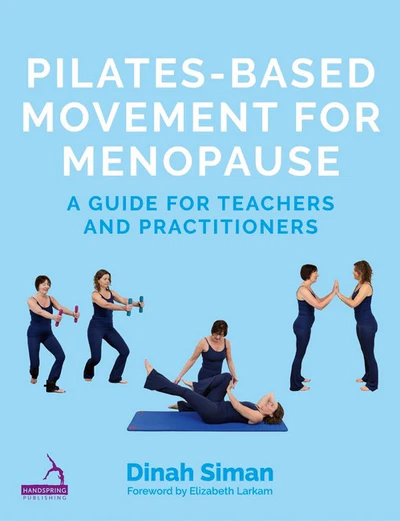
I personally put my hand up to review the book Pilates-Based Movement for Menopause: A Guide for Teachers and Practitioners by Dinah Siman as it is something I am going through at the moment, and have a handful of clients going through the same experience.
This book is a very detailed guide/ practical manual / book on how Pilates-based movement supports women/ individuals experiencing symptoms of menopause. What I like is the open-mindedness of Dinah, as she points out that ‘In order to be trans-inclusive, she uses ‘women, trans men and non-binary people’, but she also uses ‘biologically female’ at times, and where she refers to ‘women’ only, this is generally a reflection of the clients that Dinah has worked with (very generation alpha!) considering she has been teaching since the 1990’s. As a Pilates teacher and content creator Dinah uses her platform to educate, support and encourage all women, but especially South-East Asian women, and other cultures to be proactive in their health and wellness during this stage of life.
The book is well written, easy to understand and broken into 4 parts. As a busy studio owner, finding the time to sit down and read a full book is near impossible. The book is well divided up into different topics so to be able to pick a topic/ chapter I was eager to know more about first and read it, intrigued me to go back and read the other topics/chapters when I had the time.
Each chapter focuses on different topics in an easy-to-understand way, such as; history of menopause, recognising perimenopause, the role of hormones, pelvic floor, fascial systems. Also included is research from case studies from your average person and a doctor’s experience. This book gives you additional learning and understanding about hormones, to join the dots (recognising perimenopause) with your thinking and understanding of the condition and think outside ‘just being a Pilates teacher or practitioner’. ‘Movement snacks ‘are exercises shown throughout the book to use and Reader reflections/ self-observation and activities are at the end of most topics, which I found helpful.
The book also includes the ‘Menopause symptom checker’ which is for women, trans men or non-binary persons over the age of 45 to track and record the changes and symptoms they are experiencing. Very useful to give to clients. It’s clear to see that hormonal depletion may well be playing a part in body issues, such as frozen shoulder and other problems you may witness with your clients when teaching.
The book dives deeper into conditions that most of us as Pilates teachers encounter, which Dinah indicates as ‘possible long-term symptoms of post menopause.’ Conditions such as Osteopenia, Osteoporosis, Type 2 diabetes, Inflammatory pain conditions such as fibromyalgia, arthritis and weight gain, the list goes on!
The pelvic floor chapter includes great case studies for conditions such as bowel leakage, prolapse, hysterectomy and rehab. The fascial system chapter incorporates the principles of fascial fitness, (there are 4) and a training programme that is based on fascia research findings, and gives detailed examples of methods to help and incorporate into your Pilates class planning.
Part 2, looks into evidence-based treatment for menopause, alternative and complementary therapies, and then the topic of Pilates for menopause. The information will put you, as a teacher, in a great position to help women who are going through this stage of life. The chapters in this part give you a great resource of links for professionals (all around the world) to check out. There is also a huge amount of information on HRT and its benefits and demystifying the myths of previous evidence on HRT.
Part 3, goes deep into self-care for teachers, and also how to implement Pilates for menopause ideas to get the topic out there, it also gives sample teaching plans and workshop samples for running a course on menopause that Dinah and other colleagues have used themselves. I feel these would be an excellent resource if I were to run a workshop or information session for clients, and it has given me the confidence to consider doing so. There are some excellent resources and information (evidence-based) links at the end of the chapter. There is also a great example of working with a 1:1 client, including information on programming.
Part 4, talks about her personal experience during the covid pandemic, and Dinah has referenced, authors, doctors, teachers, movement methods, menopause advocates and ongoing support networks.
In conclusion, I found this book to be well worth the read, and it gave me an understanding of the impact of perimenopause, menopause and post-menopause. It definitely offers readers confidence and a clear understanding of how to support women during this stage of life, especially for a Pilates teacher in a studio environment.
Written by Aisling Harris
Peninsula Pilates Studio
PAA Pilates Practitioner L4
PAA Members – 20% discount off Pilates-Based Movement for Menopause by Dinah Siman
Pilates-Based Movement for Menopause by Dinah Siman was generously supplied for review by Woodslane Health and is available to PAA members with 20% discount.
Woodslane Health is the local distributor in Australia for Handspring Publishing and Singing Dragon Publishers. Handspring and Singing Dragon publish a range of authoritative bodywork, manual therapy, and complementary health titles for professionals, trainers, teachers and general readers.
Woodslane Health are excited to offer PAA members a 20% discount across all their titles with free delivery for orders over $100.
PAA Members: Check under Resources in your membership area for the Woodslane Health discount code.

Comments are closed.